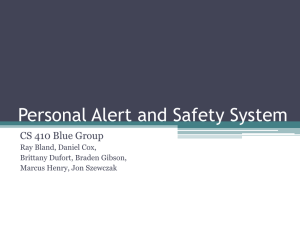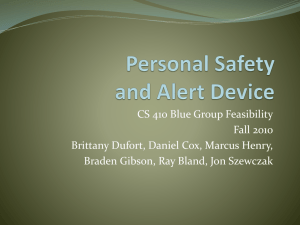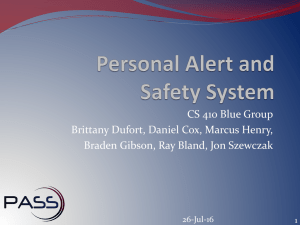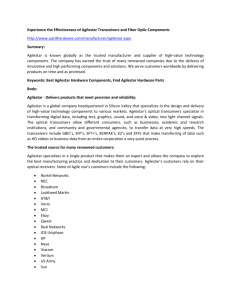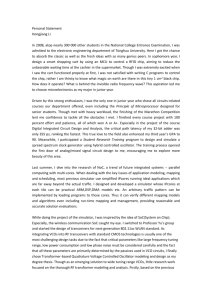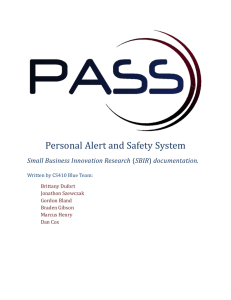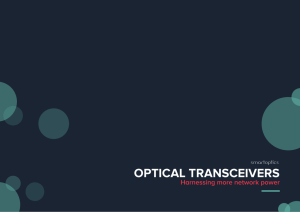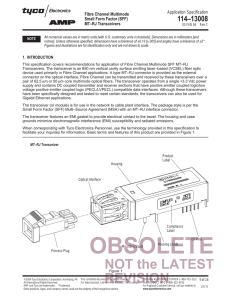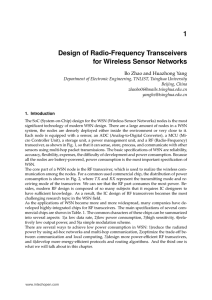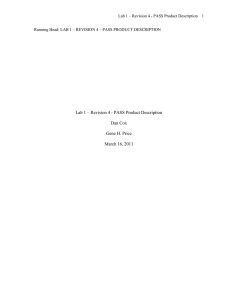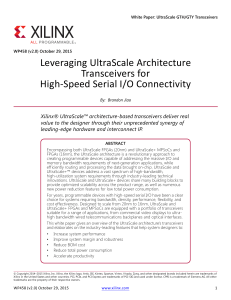CS 410 Blue Group Brittany Dufort, Daniel Cox, Marcus Henry, 26-Jul-16
advertisement
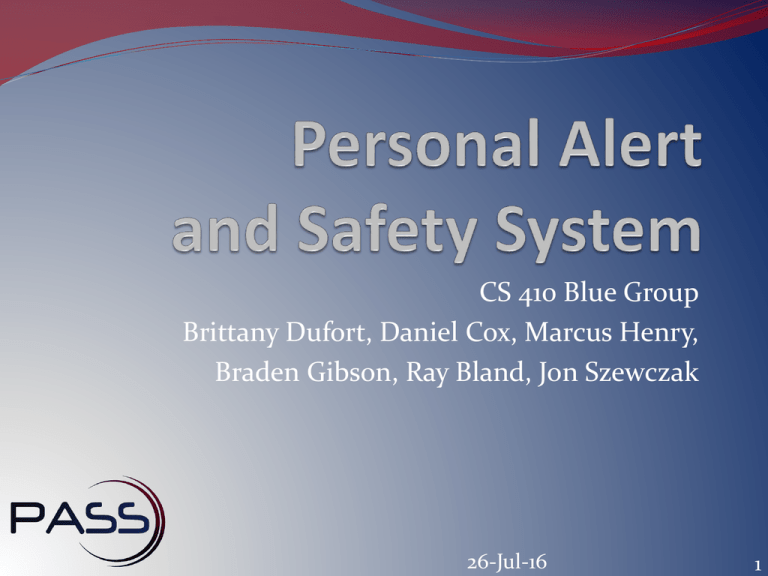
CS 410 Blue Group Brittany Dufort, Daniel Cox, Marcus Henry, Braden Gibson, Ray Bland, Jon Szewczak 26-Jul-16 1 Gene Price General Manager Brittany Dufort Project Manager Marcus Henry Jon Szewczak Hardware Development, Financial Specialist Hardware Development, Financial Specialist Daniel Cox Assistant Manager, Web Developer Braden Gibson Software Development, Public Outreach 26-Jul-16 Ray Bland Database Specialist, Public Outreach 2 Background In times of need people call 9-1-1 for emergency assistance. Personal Crimes (i.e. Robberies, Assaults) Accidents and/or Injuries Existing security paradigms rely on verbal communication with people in need – which usually comes after the event has occurred. During a personal crime the victim often cannot call 91-1 for fear of aggravating the assailant. 26-Jul-16 3 Response Time U.S. Department of Justice Office of Justice Programs Bureau of Justice Statistics http://bjs.ojp.usdoj.gov/content/pub/pdf/cvus07.pdf Page 115, Table 107 26-Jul-16 4 Societal Problem In the event of a personal crime or emergency, security professionals at higher education, business and civil complexes need an effective way to allow individuals to quickly and silently communicate their location to first responders. 26-Jul-16 5 Proposed Solution Individuals would be equipped with a key fob. Pressing a button or combination of buttons would trigger an alert at a security dispatch center. The alert would be repeated every 30 seconds until first responders reset the unit. 26-Jul-16 6 How It Would Work Through a series of transceivers that signal would be translated to dispatch. When a fob button(s) is pushed a signal would be sent out. The dispatch station will have a graphic user interface that maps the location of the emergency beacon. Once activated the fob would automatically repeat its broadcast until reset by responders. Dispatch would route a responder at a high priority to assess the situation. 26-Jul-16 7 Benefits of Solution Aids in improving response time First responders do not need location information from victims. Victims do not have to fumble around for a cell phone and dial a number; a button push is all that is required to summon aid. If the victim is moving (i.e. on the run), the system will report their movement. Based on proven technology. Could act as a deterrent. 26-Jul-16 8 Competition Handheld Device Expandable Long Range PASS Safety Alarms Centurion Guardian Medical Alert Alarms a a a a a Silent Alarm Location Info a a a a r r r r a* a** a a** r a r r r a*** a a * With vendor assistance only and requires software upgrade ** Maximum number of repeaters (300) limits coverage area *** Only if preprogrammed messages include a location 26-Jul-16 9 Determining Customer Many possible customers: Universities or Colleges Business complexes (i.e. Google, Microsoft, Intel, Trump Tower) Civil complexes (i.e. the Capitol Building) Scoping Issues The initial focus will be on Universities. 26-Jul-16 10 Old Dominion University Prime Candidate Spends approximately $262,000.00 on security every year.1 Personnel, Security Devices, etc. In 20082 10 personal crimes on campus 2 in residence halls 4 off campus 46 in the surrounding neighborhoods That averages 1 crime per week for the entire year. 1. Virginia.gov - Commonwealth Data Point 2. ODU Police Department Crime Statistics 26-Jul-16 11 Old Dominion University Refer to the handout to match up locations with crime descriptions. Wilson, Patrick. “Robbery Crimes At Or Near Campus.”The VirginianPilot 03 Nov. 2010. 09 Nov. 2010: B3 . 26-Jul-16 12 Old Dominion University The interest in the concept is very high. In October two team members met with ODU Police officials. Officials displayed remarkable enthusiasm 26-Jul-16 13 Technical Aspects Radio based Key fob alert units (approx. 100’ range) Transceivers stationed to give maximum coverage to the most logical areas Transceivers would serve as signal relays Possible solar power option for transceivers 26-Jul-16 14 Technical Aspects (continued) A master receiver which would interface with the Master Control Unit (server) at a dispatch station. A software suite Graphic User Interface for Dispatch Personnel Master Control Unit Software Triangulation Database Signal Processing 26-Jul-16 15 Data Flow Relay to another transceiver Key Fob Signal Sent Wired Power Long Range Wireless Transceiver Signal Received Master Control Unit Master Receiver Server Decodes Received Message Packet Queries Database Triangulates Position Wireless Transceiver Signal Transmitted Prefix Appended If None Exists No In Range of Master Receiver Yes Database 26-Jul-16 Graphic User Interface Location of Signal Data About User 16 Database Schema 26-Jul-16 17 Graphic User Interface Web Application Uses Google® Maps API or some other mapping utility Reports location of victim Allows for notations about alert Allows for easy transceiver health pole. Demo 26-Jul-16 18 Milestones – Phase 1 Defining System Requirements Approach ODU Define Budget Requirements Prototype Acquire Hardware and Setup for Concept Test Develop Basic Software Package Based on Requirements Perform Test and Analyze Phase 1 WBS 26-Jul-16 19 Milestones – Phase 2 Finalize Hardware Designs Finalize Software Designs Complete Production Drawings Develop Documentation Based on Final Designs Seek New Customers Review Budget and Establish Requirements for Continuation Phase 2 WBS Phase 2 WBS (continued) 26-Jul-16 20 Milestones – Phase 3 & Beyond Begin Production (subcontracted) Receive Production Units Complete Full System Tests Complete Documentation Ship to Customer Continue Marketing and Business Development Establish Support Center Phase 3 WBS 26-Jul-16 21 Risk Management Financial Technical Legal Other 26-Jul-16 22 Risk Matrix 26-Jul-16 23 Risks Cost to Customer Effective marketing Universities could seek grants and incorporate cost into student fees. Initial Cost Outlay Cost effective suppliers Venture capitalist funding Partnering with a larger firm 26-Jul-16 24 Risks (continued) Radio Signal Interference Control Unit / Server software to ensure no false signals Make use of the repeated signal System Maintenance Low maintenance designs – to include solar power options and rugged enclosures. System Malfunction (i.e. Fails to Send Alert) Make sure that a disclaimer is prominently displayed 26-Jul-16 25 Risks (continued) False Alarms Enact policies stipulating penalties for misuse Include as part of a Universities Honor Code System Abuse A Fob will be de-authorized upon being lost or stolen. Any signal from a de-authorized device is ignored. FCC Regulations Work closely with FCC representatives. 26-Jul-16 26 Pricing Model Base Package – $300,000 Installation Support Survey of Complex and Recommended Transceiver Locations 5,000 Transceivers 3,000 Fobs 1 Master Receiver All Software NOTE: Master Control Unit Server hardware to be provided by customer infrastructure. 26-Jul-16 27 Pricing Model (cont’d) Optional Packages Additional Fobs (1,000 each) - $25,000 Additional Transceivers (1,000 each) $45,000 for solar power option $30,000 for non-solar power option Maintenance and Support - $25,000 per year All software upgrades, fixes and patches included. Faster response time for support correspondence. Limited on-site support (for additional fee). 26-Jul-16 28 ODU Costs Based on Pricing Model $300,000 $75,000 $60,000 + $25,000 $460,000 Base Package Additional Fobs – 3 @ $25,000 Additional Transceivers – 2 @ $30,000 1 Year Maintenance & Support 4,500 Students Living on Campus (approximately) 1,600 Faculty and Staff (optional) 6,100 Population (estimated Max) The number of Transceivers Depends on the Desired Coverage Area (estimated 7,000 total receivers). 26-Jul-16 29 PASS Costs Based on Pricing Model Fobs $20 1 Transceivers $25-$36 Board $16 2 Enclosure $8 3 Battery $1 Solar Power (optional) $15 4 Master Receiver $50 - $100 Software Development $200,000 (estimate) Hardware Fabrication $60,000 (estimate) 1. 2. 3. 4. TOTALS Base Package $430,000 - $500,000 Additional Fobs $20,000 Additional Transceivers $25,000 - $39,000 http://www.sparkfun.com/commerce/product_info.php?products_id=8602 http://www.sparkfun.com/commerce/product_info.php?products_id=705 http://www.pactecenclosures.com/product-detail.php?classid=36 http://store.sundancesolar.com/small-encapsulated-solar-panels.html 26-Jul-16 30 Operational Costs Phase 1 Staffing: $176,120 Facilities: Donated by ODU Equipment: Donated by ODU Prototype Hardware: $100 For full staffing breakdown see data sheet 26-Jul-16 31 Operational Costs Phase 2 Staffing: $315,392 Facilities: $27,000 per year 2,000 sf facility @ $13.50 per sf 1 Equipment: $30,000 per year System Hardware: $400,000 (see pricing model) For full staffing breakdown see data sheet 1. Commercial Real Estate Guide 26-Jul-16 32 Operational Costs Phase 3 & Beyond Staffing: $459,536 Facilities: carried over from Phase 2 Equipment: carried over from Phase 2 Marketing: $10,000 System Hardware: $255,000 For full staffing breakdown see data sheet 26-Jul-16 33 Break Even Point Need 5 Sales to Break Even 3,000,000.00 2,500,000.00 2,000,000.00 Cost by Sale 1,500,000.00 Income 1,000,000.00 500,000.00 0.00 0 0 1 2 3 4 5 26-Jul-16 34 Questions? 26-Jul-16 35 Data Representation in Master Control Unit 26-Jul-16 36
